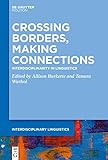Crossing Borders, Making Connections : Interdisciplinarity in Linguistics / ed. by Allison Burkette, Tamara Warhol.
Material type: TextSeries: Interdisciplinary Linguistics [INTLING] ; 1Publisher: Berlin ; Boston : De Gruyter Mouton, [2021]Copyright date: ©2021Description: 1 online resource (IX, 300 p.)Content type:
TextSeries: Interdisciplinary Linguistics [INTLING] ; 1Publisher: Berlin ; Boston : De Gruyter Mouton, [2021]Copyright date: ©2021Description: 1 online resource (IX, 300 p.)Content type: - 9781501520709
- 9781501514395
- 9781501514371
- online - DeGruyter
- Issued also in print.
| Item type | Current library | Call number | URL | Status | Notes | Barcode | |
|---|---|---|---|---|---|---|---|
 eBook
eBook
|
Biblioteca "Angelicum" Pont. Univ. S.Tommaso d'Aquino Nuvola online | online - DeGruyter (Browse shelf(Opens below)) | Online access | Not for loan (Accesso limitato) | Accesso per gli utenti autorizzati / Access for authorized users | (dgr)9781501514371 |
Frontmatter -- Acknowledgments -- Contents -- Chapter 1. Introduction: Why interdisciplinarity? -- Chapter 2. The value of interdisciplinary and transdisciplinary linguistic research -- Chapter 3. Faculty and student affairs partnerships: Creating inclusive campus environments for students of diverse linguistic backgrounds -- Chapter 4. Critical race theory and the new sociolinguistics -- Chapter 5. You don’t even try to understand!: Interdisciplinarity in language and gender studies -- Chapter 6. Ecolinguistics as a transdisciplinary movement and a way of life -- Chapter 7. Ethnography in interdisciplinary research in linguistics -- Chapter 8. Connections and interdisciplinarity: Linguistic Atlas Project data from an assemblage perspective -- Chapter 9. Reassembling linguistics: Semiotic and epistemic assemblages -- Chapter 10. Language ideological assemblages within linguistic anthropology -- Chapter 11. A case of archeological classification -- Chapter 12. Language and materiality in global capitalism -- Chapter 13. The language of building in the southern American colonies -- Chapter 14. Historical sociolinguistics and the necessity of interdisciplinary collaboration -- Chapter 15. Comprehensive review of the effect of using music in second language learning -- Chapter 16. Trashing the Bible -- Chapter 17. Towards a post-structuralist economics -- Chapter 18. Life as a linguist among clinicians: Learnings from interdisciplinary collaborations on language and health -- Index
restricted access online access with authorization star
http://purl.org/coar/access_right/c_16ec
This edited volume explores the scope of interdisciplinary linguistics and includes voices from scholars in different disciplines within the social sciences and humanities, as well as different sub-disciplines within linguistics. Chapters within this volume offer a range of perspectives on interdisciplinary studies, represent a connection between different disciplines, or demonstrate an application of interdisciplinarity within linguistics. The volume is divided into three sections: perspectives, connections, and applications. Perspectives The goal of this section is to address more generally the definition(s) of and value of multi-, trans-, and inter-disciplinary work. In what areas and for what purposes is there a need for work that crosses discipline boundaries? What are the challenges of undertaking such work? What opportunities are available? Connections This section features paired chapters written by scholars in different disciplines that discuss the same concept/idea/issue. For example, a discussion of how "assemblage" works in archaeology is paired with a discussion of how "assemblage" can be used to talk about ‘style’ in linguistics. Applications This section can be framed as sample answers to the question: What does interdisciplinarity look like?
Issued also in print.
Mode of access: Internet via World Wide Web.
In English.
Description based on online resource; title from PDF title page (publisher's Web site, viewed 25. Jun 2024)


